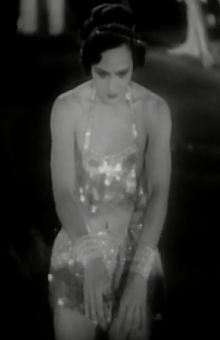
Klili doing her voodoo dance
Klili Gordon (Fredi Washington), a plantation owner and voodoo priestess, has had a two year affair with white man Adam Maynard (Philip Brandon), but on his travels to the United States, he’s gotten engaged to a white woman and is bringing her back to the islands. The black overseer (Sheldon Leonard—yes, Jewish Sheldon Leonard, who’d later produced The Dick Van Dyke Show, and no, he isn’t in blackface) wants Klili for his own and tries to convince her to stick to her own kind. But Klili isn’t going to give up, and after begging Adam to take her, resorts first to a curse, and then to raising zombies.
In the ‘30s there were a substantial number of “race movies” made, with mostly black casts and crews and intended for purely black audiences in segregated theaters, though they were made by white-owned companies and often had a white director. These movies had tiny budgets, even by the standards of Poverty Row. They didn’t get good equipment or the training to use it. Few of the actors were pros and little care was given to hiring skilled people behind the cameras (director George Terwilliger was a silent filmmaker who hadn’t worked in 10 years). Surprisingly the depiction of blacks wasn’t much better in “race movies” than in more mainstream ones. Some of these films would be set (and perhaps filmed) outside of the US, as in this case in the West Indies, but would normally include a male comic relief character from Harlem. (Ouanga was set to film in Haiti with part of the team doing research by watching an actual voodoo service, but they offended the locals and one or two crew members ended up dead—the number is as vague as what exactly happened—so they moved to Jamaica). Another aspect common to these films is how pale skinned the black leads are. I would not have guessed that Washington was black if I hadn’t read it.
With all that, Ouanga is… interesting. It is poorly made. Let’s make that terribly made. The editing is primitive, causing the film to leap from the ridiculous prologue on how nice the islands are and the terrors of voodoo to a dance at a voodoo ceremony (that doesn’t look too bad) and then onto a ship at some unknown time later. Well, it doesn’t drag due to those wild jumps. Nothing indicates that anyone involved knew how to make a movie. But it also is one of the first voodoo horror films and is the second zombie film ever made. And while the cast is generally dreadful, Fredi Washington has plenty of charisma. Her acting only rises a touch above the others, but natural charm makes up for a lot.
While many “race movies” avoided direct commentary on black/white racial relationships, Ouanga dives in. It’s filled with lines like:
“You belong with your kind”
“Am I not as beautiful, as white?”
“She’s his kind. She’s white.”
“Your white skin doesn’t change what’s inside you. You’re black.”
Race commentary in a horror movie could be great stuff, but that requires some artistry and skill, and none is to be found here. At times you could read Ouanga as racist and at others you could read it as fighting racism. If there’s a message, and I’m not sure that there is, it’s “Stick to your own kind.”
Ouanga doesn’t approach being good or competently made, and has a “questionable” theme, if I’m being charitable, but between Washington dancing and the zombies, it isn’t a movie that horror fans should ignore.
It was loosely remade as The Devil’s Daughter (1939).